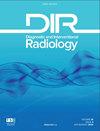Relative contribution of susceptibility weighted imaging, compared to conventional MRI, in the detection of common bile-duct calculi.
IF 2.1
4区 医学
Q2 Medicine
引用次数: 0
Abstract
PURPOSE We aimed to evaluate the relative contribution of susceptibility weighted imaging (SWI) in the detection of common bile-duct (CBD) stones in comparison to the conventional MRI protocol containing magnetic resonance cholangiopancreatography (MRCP), balanced turbo field echo (BTFE), and T2-weighted spin-echo imaging techniques. METHODS MRI data containing MRCP, BTFE, T2-weighted imaging, and abdominal SWI were independently evaluated by 2 sets of experienced radiologists in 44 patients with confirmed CBD stones. Endoscopic retrograde cholangiopancreatography, and endoscopic ultrasound where available, was used as the reference gold standard. Evaluation was performed for the visualization of CBD stones in each of the MRI techniques. Relative contribution of SWI was classified into one of four categories for each case: (1) no contribution to CBD stone visualization; (2) same as conventional techniques; (3) improved diagnostic confidence; and (4) critical for diagnosis. Stone size was also assessed. RESULTS Inter-rater agreement coefficient for CBD stone visualization was found to be "good" in MRCP (0.77), "very good" in SWI (0.94) and BTFE (0.84), and moderate in T2-weighted imaging (0.54). CBD stones were visualized with SWI in 86.4% and 82%, with MRCP in 70.5% and 70.5% cases, with BTFE in 73% and 61.4% cases, with T2-weighted imaging in 45.5% and 52.3% cases by reviewers 1 and 2, respectively. SWI did not contribute to CBD stone visualization in 2.3% (1/44); was the same as conventional techniques in 31.8% (14/44) cases; improved diagnostic confidence in 34.1%; and was critical for diagnosis in 20.5% cases. CONCLUSION SWI has the potential to serve as a strong adjunct to conventional MRI protocols used for CBD stone evaluation with very small scan-time penalty.与传统MRI相比,磁化率加权成像在检测胆总管结石中的相对贡献。
我们旨在评估磁化率加权成像(SWI)在检测胆总管(CBD)结石方面的相对贡献,与包含磁共振胰胆管成像(MRCP)、平衡涡轮场回波(BTFE)和T2加权自旋回波成像技术的传统MRI方案相比。方法由2组经验丰富的放射科医生对44例确诊为CBD结石的患者的MRI数据进行独立评估,包括MRCP、BTFE、T2加权成像和腹部SWI。内窥镜逆行胰胆管造影和内窥镜超声(如有)被用作参考金标准。对每种MRI技术中CBD结石的可视化进行评估。SWI的相对贡献被分为四类之一:(1)对CBD结石可视化没有贡献;(2) 与传统技术相同;(3) 提高诊断置信度;和(4)对诊断至关重要。还评估了石头的大小。结果MRCP显示CBD结石的评分者间一致性系数为“良好”(0.77),SWI(0.94)和BTFE(0.84)为“非常好”,T2加权成像为中等(0.54),分别地在2.3%(1/44)中,SWI对CBD结石可视化没有贡献;31.8%(14/44)的病例与传统技术相同;诊断置信度提高34.1%;20.5%的病例对诊断具有重要意义。结论SWI有潜力作为传统MRI方案的有力辅助,用于CBD结石评估,扫描时间损失很小。
本文章由计算机程序翻译,如有差异,请以英文原文为准。
求助全文
约1分钟内获得全文
求助全文
来源期刊
CiteScore
3.50
自引率
4.80%
发文量
69
审稿时长
6-12 weeks
期刊介绍:
Diagnostic and Interventional Radiology (Diagn Interv Radiol) is the open access, online-only official publication of Turkish Society of Radiology. It is published bimonthly and the journal’s publication language is English.
The journal is a medium for original articles, reviews, pictorial essays, technical notes related to all fields of diagnostic and interventional radiology.

 求助内容:
求助内容: 应助结果提醒方式:
应助结果提醒方式:


